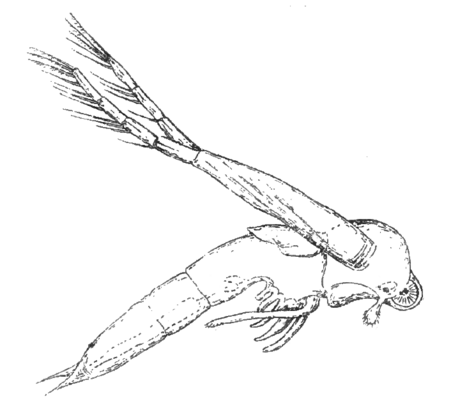薄皮蚤属(学名:Leptodora)为薄皮蚤科动物唯一的一个属。过往本属只有透明薄皮蚤(学名:Leptodora kindtii)一个物种,直至2009年本属的第二个物种被发现。这两个物种在对比其他双甲下纲物种来说比较大,近乎透明及透光,是一类捕食性物种。本属物种最长可长至21 mm(0.83英寸),有两枝可用作游泳的触角,以及一只复眼。腿可用作捕捉碰巧路过的桡足亚纲物种。
透明薄皮蚤见于北半球温带的湖泊中,很可能是枝角目物种当中唯一曾被报章报导过的已描述生物;而L. richardi现时只见于俄罗斯远东地区的黑龙江流域,尽管日本认为在其国内分布的物种亦是L. richardi。
在一年内绝大多数时候,薄皮蚤属物种只会进行单性生殖,当中雄性物种只会在季度
细水蚤属是水蚤属。它是一种大型物种,体长超过1厘米,身体细长,具有掠食性。过去人们认为它是单一物种,但现在有一个理论认为它是多个物种。如果这一点得到证实,则日本物种就是 Leptodora richardi 。
For most of the year, Leptodora reproduces , with males only appearing late in the season, to produce winter eggs which hatch the following spring. Leptodora is the only genus in its family, the Leptodoridae, and suborder, Haplopoda.
形态描述
薄皮蚤属物种的成体是北美洲原生浮游枝角目物种当中体型最大的[3];至于到底有多大,各种报告间不尽相同,但雌性成体普遍可长至12 mm(0.47英寸)长[4],部分报告声称可长至21 mm(0.83英寸)长[5]。这些动物的身体约有98%是透明的[6],以避免被鱼类猎食[7]。
Lilljeborg notes:[8]
Das Weibchen ist in so hohem Grade durchsichtig, in wahrem Sinne »wasserhell», dass oft nur die Bewegungen ihr Dasein in dem Wasser verrathen. Bei auffallendem Sonnenlicht wird gewöhnlich der Schatten früher als das Thier selbst entdeckt.
The female is transparent to such a high degree, literally "as clear as water", that her presence is often only given away by her movements. In bright sunlight, the shadow is normally seen before the animal itself.
The male is similarly transparent.[8] The abdomen is elongated, but the carapace is small and only covers the brood pouch.[6]
胸节的六对附肢形成一个“喂哺篮”,用以捕捉猎物[9]。 The second 触角 are used for swimming, while the first antennae are 痕迹器官 in females but elongated in males, where they are used in 有性生殖.[6] There is a single large 复眼 which takes up much of the animal's head.[6] It comprises around 500 facets, which are spherically arranged, and the whole eye is movable by up to 10° in any direction.[10]
分布
透明薄皮蚤广泛分布于北半球温带的湖泊中,见于北美洲、亚洲、欧洲及非洲。在北美洲,其分布范围南至德克萨斯州及俄克拉荷马州[11];在中国大陆分布于浙江、江苏、安徽、江西、湖北、吉林、黑龙江、云南、内蒙古等地[1],主要栖息于大中型湖泊的敞水区、也出现在沿岸以及小型湖泊与积水较深的池塘中[1]。在欧洲、北非部分地区、阿拉伯半岛北部及亚洲喜马拉雅山脉以北地区亦有分布[6]。
生态及行为


透明薄皮蚤是一种贪婪的捕食者,能够控制其偏爱猎物的数量[12],一般都是溞属(Daphnia)、Bosmina, Ceriodaphnia, Diaphanosoma, Diaptomus, Polyphemus及剑水蚤属(Cyclops)等各属物种的幼体[6]。 It seems to encounter its prey by chance, with contact initiating a 反射 (生理学), in which the 腹 is brought forward to close the feeding basket. In many cases, the prey escapes this haphazard response. Juvenile Daphnia are slower than adults to respond to the predator's attack, and are therefore more likely to be caught.[13]
The most important predators of Leptodora are fishes, including 白鲑属, perch, ziege and 欧白鱼.[12]
In 琵琶湖, 日本, L. kindtii is 寄生 by the 线虫动物门 Raphidascaris biwakoensis, a parasite of 鱼.[14]
生命周期
雌性薄皮蚤属动物能够仅仅透过单性生殖就可以产卵,而且每隔12小时就又可以再下一窝卵子[15]。这些卵子孵化后进入幼体阶段,身长约2毫米(0.079英寸)。之后牠们在长为成虫之前,还要再经历六个instar,到了完全成长,体长增至6毫米(0.24英寸)[15]。而事实上,从孵化到成虫阶段,需时只要3到6天,视乎孵化时的环境温度[15]。在一年的绝大多数时候,薄皮蚤属动物的繁殖都只靠单性生殖,所生产的卵皆为雌性,并没有雄性的卵子 [6]。到了秋季,透过单性生殖的雄性卵子开始出现[5];雄性与雌性进行有性生殖才变得可行。这些透过交配行为诞下的受精卵会在牠们越冬的所在地沉到最底[8],直到下一年才会孵化,成为 nauplius-like larvae.[6]。
Related taxa
Leptodora is so distinct from other cladocerans that some authors have suggested grouping all other cladocerans into a 演化支 called "Eucladocera", with Leptodora as its 姐妹群. It is now believed, however, that Leptodora is sister to Onychopoda, being the only genus in the family Leptodoridae and the subclass Haplopoda.[16] Features which separate it from other families include its large size, the lack of branchial appendages (鳃s) on its legs, the reduction of the carapace, and the fact that the winter eggs hatch as nauplii.[6]
Taxonomic history

Leptodora kindtii is "probably the only cladoceran ever described in a newspaper".[17] The German microscopist Gustav Woldemar Focke organised a 学术研讨会 in 不来梅 in 1844 together with the pharmacist Georg Christian Kindt. He studied the fauna of the ditches surrounding the city (the Bremer Stadtgraben) and displayed live specimens at the meeting. During the meeting, he also published a description of the species in the Weser-Zeitung on Sunday September 22, 1844, placing the species in the genus Polyphemus.[17] However, this description was ignored by the scientific community, and Wilhelm Lilljeborg described the species in 1861 with the name Leptodora hyalina. The 异名 was not noticed until Simon Albrecht Poppe informed Lilljeborg of it in 1889,[17] and Lilljeborg corrected the error in his 1900 专著.[8]
2009年,Korovchinsky首度为本属的第二个物种Leptodora richardii作出描述:这个物种采样自黑龙江盆地的湖泊,包括博隆湖[2]。
现时下列组合均被视为透明薄皮蚤(Leptodora kindtii)的异名[18]:
- Polyphemus kindti Focke, 1844
- Hyalosoma dux Wagner, 1868
- Leptodora angusta Sars, 1890
- Leptodora hyalina Lilljeborg, 1861
- Leptodora pellucida Joseph, 1882
The name Leptodora is from the 希腊语 words leptos and dora, collectively meaning thin-skinned.[19] The 种加词 kindtii is presumed to refer to G. C. Kindt, who worked closely with Focke.[17] The alternative spelling kindti is sometimes encountered,[20] but is no longer considered correct under the 国际动物命名法规.[21] The epithet hyalina, used by Lilljeborg, is from the Greek ὕαλος, and means glassy.[19]
下属物种
本属包括以下物种:[22]
- Leptodora kindti (Focke, 1844)
- Leptodora richardi Korovchinsky, 2009
参考文献
外部链接
Wikiwand in your browser!
Seamless Wikipedia browsing. On steroids.
Every time you click a link to Wikipedia, Wiktionary or Wikiquote in your browser's search results, it will show the modern Wikiwand interface.
Wikiwand extension is a five stars, simple, with minimum permission required to keep your browsing private, safe and transparent.

